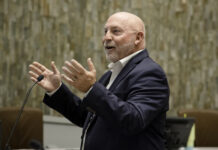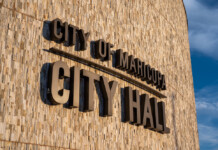
Planes, trains, automobiles and a helicopter.
Maricopa leaders have taken to the sky to solve the problem of separating the Union Pacific railroad tracks from State Route 347 where they cross.
Taking a show-as-well-as-tell approach to decision-makers at the Arizona Department of Transportation, Mayor Christian Price arranged for board members to go on a helicopter ride to see the traffic backups below.
Officials have flown to the nation’s Capitol to lobby on behalf of making the grade-separation project a high priority.
Maricopa hosted ADOT’s state transportation board’s Nov. 17 regular meeting, leveraging that meeting from the helicopter tour — courtesy of Salt River Project — to a reception dinner the night before with a presentation on the project explaining its regional, not just local, importance.
“The board members were very impressed with the presentation,” said former Mayor Kelly Anderson, a member of the board.
Getting to the top of ADOT’s to-do list
Price said the purpose of the meeting “was to get on their radar.”
“They have a three- to five-year plan in which the top (five to 10 priorities) on their list change” depending on who is chairman and a host of other factors, he said.
“They needed to know our story. They needed to know why we should be a priority. They needed to know how serious we were about getting this accomplished.”
Two members of the transportation board came up to him, Price said, and were “just amazed” at what the city has done on its own.
During the meeting, Maricopa Unified School District Superintendent Steve Chestnut told the ADOT board members 42 school buses and seven vans crossed the dangerous intersection some 230 times a day.
“That was a very large and important number to all of us up there,” Anderson said.
Chestnut pointed out the train schedule had an adverse effect on students and staff being on time to school.
“As a result of crossing the train track, we have students late for class on a daily basis,” Chestnut said. “So it’s a major issue in our district.”
“I would greatly prefer that there were zero crossings of a high-speed train track rather than 230,” Chestnut said.
Scott Bartle, president of the school district governing board, reminded the ADOT board it wasn’t just buses crossing the tracks.
“We have about 6,000 students here in our school district, and many more school-age children in this community who are crossing the railroad multiple times a day,” Bartle said.
Asad Karim, ADOT’s project manager for the grade separation study, said the project needs to have funding in place for the second phase, which includes engineering and building, to begin.
When Anderson was mayor in 2006, he said a project assessment had already been completed.
But then “the Great Recession hit,” Anderson said. The funding for a project of this magnitude became nonexistent, especially in Maricopa, one of the hardest-hit cities in the housing crash.
The state, which was facing a deficit that would grow to nearly $2 billion by 2009, couldn’t subsidize the project, either.
But now, with the economy haltingly improving, Anderson said, “We’re starting to put the heat on again.”
The city didn’t let the issue languish during the rough economy. It was setting aside funds and has split the cost of necessary initial studies equally with ADOT.
For another rail project, the city received a $300,000 grant from the Gila River Indian Community to study relocating the Amtrak passenger loading station, which also disrupts vehicle traffic on the major thoroughfare.
Grade-separation studies include an initial scoping, alternatives development, environmental studies, an initial design concept report and then a final design concept report and final environmental study. They are costly and aren’t scheduled to be completed until late next year.
Tom Duensing, director of the city’s finance and administration department, said the Maricopa City Council has allocated $3.9 million of capital improvement funds for the project for the 2012-2013 fiscal year.
In the 10-year capital improvement plan, the city plans to allocate another $3.9 million.
Anderson said Maricopa also made sure the project stayed on federal authorities’ radar, even going to Washington, D.C. to lobby for it.
Maricopa’s former director of developmental services Brent Billingsley said the cost of the initial studies is “one of the biggest things that could be done.”
Still, Billingsley also acknowledged that ultimately “the key to going forward is going to be getting the funding for the engineering.”
Funding options
The good news is that there are plenty of funding options and ideas.
“There’s a lot of ways this can get done,” Anderson said.
In addition to state and federal grants, Anderson listed creating a transportation authority, similar to the road improvement district that helped to build State Route 347, to generate the required revenue.

![3 things to know about the new city budget Vice Mayor Amber Liermann and Councilmember Eric Goettl review parts of the city's 2024 operational budget with Mayor Nancy Smith on April 24, 2024. [Monica D. Spencer]](https://www.inmaricopa.com/wp-content/uploads/2024/04/spencer-042424-preliminary-budget-meeting-web-218x150.jpg)




![Elena Trails releases home renderings An image of one of 56 elevation renderings submitted to Maricopa's planning department for the Elena Trails subdivison. The developer plans to construct 14 different floor plans, with four elevation styles per plan. [City of Maricopa]](https://www.inmaricopa.com/wp-content/uploads/2024/04/city-041724-elena-trails-rendering-218x150.jpg)
![Affordable apartments planned near ‘Restaurant Row’ A blue square highlights the area of the proposed affordable housing development and "Restaurant Row" sitting south of city hall and the Maricopa Police Department. Preliminary architectural drawings were not yet available. [City of Maricopa]](https://www.inmaricopa.com/wp-content/uploads/2024/04/041724-affordable-housing-project-restaurant-row-218x150.jpg)

![City looks to lower property taxes again City Manager Ben Bitter speaks during a Chamber of Commerce event at Global Water Resources on April 11, 2024. Bitter discussed the current state of economic development in Maricopa, as well as hinting at lowering property tax rates again. [Monica D. Spencer]](https://www.inmaricopa.com/wp-content/uploads/2024/04/spencer-041124-ben-bitter-chamber-property-taxes-web-218x150.jpg)


![Alleged car thief released without charges Phoenix police stop a stolen vehicle on April 20, 2024. [Facebook]](https://www.inmaricopa.com/wp-content/uploads/2024/04/IMG_5040-218x150.jpg)

![3 things to know about the new city budget Vice Mayor Amber Liermann and Councilmember Eric Goettl review parts of the city's 2024 operational budget with Mayor Nancy Smith on April 24, 2024. [Monica D. Spencer]](https://www.inmaricopa.com/wp-content/uploads/2024/04/spencer-042424-preliminary-budget-meeting-web-100x70.jpg)


